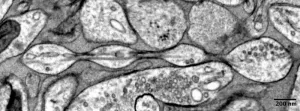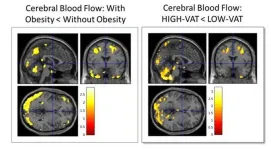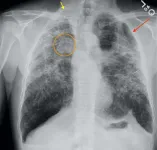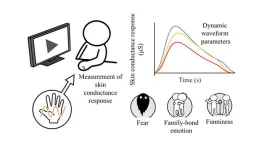(Press-News.org) **EMBARGOED FOR RELEASE UNTIL MONDAY, DEC. 2, AT 5 A.M.**
Biology textbooks may need a revision, say Johns Hopkins Medicine scientists, who present new evidence that an armlike structure of mammalian brain cells may be a different shape than scientists have assumed for more than a century.
Their study on mouse brain cells shows that the cells’ axons — the armlike structures that reach out and exchange information with other brain cells — are not the cylindrical tubes often pictured in books and on websites but more like pearls on a string.
A report on the findings is published online Dec. 2 in Nature Neuroscience.
“Understanding the structure of axons is important for understanding brain cell signaling,” says Shigeki Watanabe, Ph.D., associate professor of cell biology and neuroscience at the Johns Hopkins University School of Medicine. “Axons are the cables that connect our brain tissue, enabling learning, memory and other functions.”
Scientists have known that pearl-like structures in axons, referred to as axon beading, can develop in dying brain cells and in people with Parkinson’s and other neurodegenerative diseases due to the loss of membrane and skeletal integrity in neurons.
Under normal conditions, axons are thought to be shaped like tubes with a mostly constant diameter and occasional bubble-like structures (synaptic varicosities that hold globs of neurotransmitters, which enable signaling to other brain cells).
Watanabe had initially seen repeated axon pearling in the nervous system of worms and grew more curious about the structures after a discussion with Swiss scientist Graham Knott, Ph.D. A research team from Harvard University had published a study in 2012 that identified repeated “skeletal” components in axons, so the pair of researchers discussed experiments to get rid of the axon skeleton to see if the pearl structures disappear, says Watanabe.
Johns Hopkins graduate student and study first author Jacqueline Griswold tested the idea but found no effect on axon pearling.
Then, Watanabe and Griswold worked with theoretical biophysics colleague Padmini Rangamani, Ph.D., professor of pharmacology at University of California San Diego School of Medicine, to look more closely at axons’ physical properties.
To be able to see axons on brain cells (neurons), which are 100 times smaller than the width of a human hair, the scientists used high pressure freezing electron microscopy. Like standard electron microscopy, which shoots beams of electrons at a cell to outline its structure, Watanabe and his team froze mouse neurons to preserve the structures’ shape.
“To see nanoscale structures with standard electron microscopy, we fix and dehydrate the tissues, but freezing them retains their shape — similar to freezing a grape rather than dehydrating it into a raisin,” says Watanabe.
The researchers studied three types of mouse neurons: ones grown in the lab, those taken from adult mice and those taken from mouse embryos. The neurons were nonmyelinated (they were without the myelin insulating cover that surrounds the axon).
The researchers found the bubbly, pear shape of axons among all of the tens of thousands of images taken of the tissue samples.
The scientists named the pearl-like structures in which the axon swells “non-synaptic varicosities.”
“These findings challenge a century of understanding about axon structure,” says Watanabe.
The scientists also used mathematical modeling to see if the axon membrane influenced the shape or presence of the pearl on a string structure. They found that simple mechanical models could be used to explain these structures very effectively.
Furthermore, experiments with the mathematical model and mouse brain samples showed that increasing the concentration of sugars in the solution around the axon or decreasing tension in the axonal membranes reduced the pearl structures’ size.
In another experiment, the scientists removed cholesterol from the neuron’s membrane to make it less stiff and more fluid-like. Under this condition, they found less pearling in both mathematical models and mouse neurons, along with reduced ability of the axon to transmit electrical signals.
“A wider space in the axons allows ions [chemical particles] to pass through more quickly and avoid traffic jams,” says Watanabe.
The scientists also applied high frequency electrical stimulation to the mouse neurons, which made pearled structures along axons swell, on average, 8% longer and 17% wider for at least 30 min after stimulation and increased the speed of electrical signals. However, when cholesterol was removed from the membrane, the axon’s pearls lost their swollen state and had no change in the speed of electrical signals.
The research team plans to examine axonal “arms” in human brain tissue taken with permission from people having brain surgery and those who have died from neurodegenerative diseases. This work formed the basis of a recently awarded Multiple Principal Investigator grant to Watanabe and Rangamani from the National Institute of Mental Health.
Funds for the research were provided by the Johns Hopkins University School of Medicine, the Marine Biological Laboratory Whitman Fellowship, the Chan Zuckerberg Initiative Collaborative Pair Grant and Supplement Award, the Brain Research Foundation Scientific Innovations Award, a Helis Foundation award, the National Institutes of Health (NS111133-01, NS105810-01A11, DA055668-01, 1RF1DA055668-01), the Air Force Office of Scientific Research (FA9550-18-1-0051), the Alfred P. Sloan Research Fellowship, a McKnight Foundation scholarship, a Klingenstein-Simons Fellowship Award in Neuroscience, a Vallee Foundation scholarship, the National Science Foundation and the Kavli Institutes at Johns Hopkins and UC San Diego.
Other researchers who conducted the study are Chintan Patel, Renee Pepper, Sumana Raychaudhuri, Quan Gan, Sarah Syed and Brady Maher from Johns Hopkins, Mayte Bonilla-Quintana, Christopher Lee, Cuncheng Zhu and Miriam Bell from the UC San Diego, Siyi Ma from the Marine Biology Laboratory, Mitsuo Suga and Yuuki Yamaguchi from JEOL in Tokyo, and Ronan Chéreau and U. Valentin Nägerl from the Université de Bordeaux in France.
DOI: 10.1038/s41593-024-01813-1
END
Study may reverse century-old understanding of the shape of ‘arms’ on mammals’ brain cells
2024-12-02
ELSE PRESS RELEASES FROM THIS DATE:
Hidden fat predicts Alzheimer’s 20 years ahead of symptoms
2024-12-02
CHICAGO – Researchers have linked a specific type of body fat to the abnormal proteins in the brain that are hallmarks of Alzheimer’s disease up to 20 years before the earliest symptoms of dementia appear, according to a study being presented today at the annual meeting of the Radiological Society of North America (RSNA). The researchers emphasized that lifestyle modifications targeted at reducing this fat could influence the development of Alzheimer’s disease.
“This crucial result was discovered because we investigated Alzheimer’s disease pathology as ...
Countertop workers exposed to serious lung disease
2024-12-02
CHICAGO – Durable and attractive, engineered stone countertops are a popular feature in modern American kitchens, but the workers who build them are risking their health. A growing number of these countertop workers are developing silicosis, a serious and long-term lung disease, according to a study being presented today at the annual meeting of the Radiological Society of North America (RSNA).
“This is a new and emerging epidemic, and we must increase awareness of this disease process so we can avoid delays in diagnosis and treatment for our patients,” ...
Higher ratio of plant protein to animal protein may improve heart health
2024-12-02
Embargoed for release: Monday, December 2, 4:00 AM ET
Key points:
In a 30-year study of American adults’ diets, those who consumed the highest ratio of plant-based protein to animal-based protein had a 19% lower risk of cardiovascular disease (CVD) and a 27% lower risk of coronary heart disease (CHD) compared to those who consumed the lowest ratio.
According to the researchers, the findings suggest that a 1:2 ratio of plant to animal protein is effective in preventing CVD—and that an even higher ratio (1:1.3) may be needed to protect against CHD.
While global dietary guidelines recommend higher intake of plant ...
Lung cancer screening CTs find coronary artery disease in 83% of cases
2024-12-02
Lung cancer screening with low-dose chest computed tomography (CT) may detect more than just lung cancer. As new research in CMAJ (Canadian Medical Association Journal) https://www.cmaj.ca/lookup/doi/10.1503/cmaj.231602 shows, these CTs can identify coronary artery calcium, a strong risk factor for coronary artery disease (CAD), in patients without cardiac symptoms.
“Lung cancer screening, although primarily geared towards reducing deaths from lung cancer, also has an opportunity to help tackle the second ...
Consumers face barriers to embracing ethical fashion, psychologist warns
2024-12-02
Consumers are likely to continue making poor fashion choices unless eco-friendly choices become more accessible, according to a leading psychologist.
Carolyn Mair says brands must do more to promote sustainable clothing by making it more accessible to all, and by doing more to educate the public about mindful consumption.
Meaningful reforms to the current model of fashion production, in which garments are made from raw materials then discarded, have lagged, says Dr Mair who is also a fashion business consultant.
Making sustainable choices
In Dr Mair’s new book The Psychology of Fashion, she says eco-labels on garments are an important influence ...
Antiretroviral drugs for treatment and prevention of HIV in adults: 2024 recommendations of the International Antiviral Society–USA Panel
2024-12-01
About The Article: This narrative review from the International Antiviral Society–USA provides updated 2024 recommendations for HIV treatment and clinical management and HIV prevention. New approaches for treating and preventing HIV offer additional tools to help end the HIV epidemic, but achieving this goal depends on addressing disparities and inequities in access to care.
Corresponding Author: To contact the corresponding author, Rajesh T. Gandhi, MD email RGANDHI@mgh.harvard.edu.
To access the embargoed study: Visit our For The Media website at this link https://media.jamanetwork.com/
(doi:10.1001/jama.2024.24543)
Editor’s ...
Virginie McNamar appointed President and Chief Operating Officer (COO) of SynGAP Research Fund (SRF) dba Cure SYNGAP1
2024-12-01
Mill Valley, CA – December 1, 2024 – SynGAP Research Fund 501(c)(3), the leading patient advocacy group working to improve the lives of SYNGAP1-Related Disorders (SRD) patients, announces the appointment of Virginie McNamar as President and Chief Operating Officer, effective December 1, 2024.
“Virginie was a respected leader in the global SYNGAP1 community before SRF was founded. Her support and guidance in the early years was critical. Almost six years later, the SRF organization has grown to the point where a full time leader ...
Planetary boundaries: Confronting the global crisis of land degradation; Potsdam institute report opens UNCCD COP 16
2024-12-01
Riyadh, Saudi Arabia – A major new scientific report charts an urgent course correction for how the world grows food and uses land in order to avoid irretrievably compromising Earth’s capacity to support human and environmental wellbeing.
Produced under the leadership of Prof. Dr. Johan Rockström at the Potsdam Institute for Climate Impact Research (PIK) in collaboration with the UN Convention to Combat Desertification (UNCCD), the report is launched as nearly 200 UNCCD member states kick off their COP 16 summit ...
VUMC and Philips landmark emissions assessment of a radiology department published in premier industry journal
2024-12-01
A seminal cradle-to-grave analysis of hospital-based radiology services by the Department of Radiology at Vanderbilt University Medical Center and Royal Philips found the energy consumption from imaging equipment accounted for more than 50% of the department’s greenhouse gas emissions and shed light on areas to focus future evidence-based strategies to decarbonize.
The life cycle assessment (LCA) results, which have been peer-reviewed and published in Radiology, found diagnostic services generate the equivalent of nearly 1,100 gas-powered cars annually, or an estimated 4.6kt carbon dioxide equivalent.
Researchers ...
When devices can read human emotions without a camera
2024-11-30
Tokyo, Japan – Researchers from Tokyo Metropolitan University have used measurements of skin conductance over time to tell emotions apart. Volunteers were shown videos depicting fearful scenes, family bonding, and humor, while their skin conductance trace was recorded. The team’s analysis showed that traces could be used to make good guesses of which emotions were being felt. Advances like this help break down an over-reliance on facial data, bringing emotionally aware technologies closer to home.
A new frontier is being pioneered in consumer electronics: one day, digital devices might be able to offer services depending on your emotional ...






